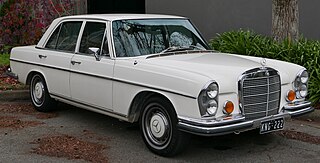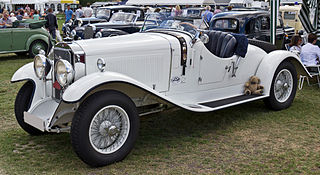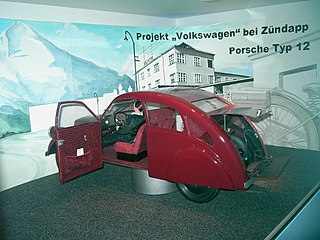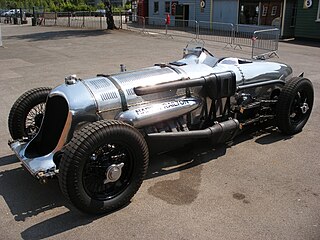
Ferdinand Porsche was an Austro-Bohemian automotive engineer and founder of the Porsche AG. He is best known for creating the first gasoline–electric hybrid vehicle (Lohner–Porsche), the Volkswagen Beetle, the Auto Union racing cars, the Mercedes-Benz SS/SSK, and several other important developments and Porsche automobiles.

Auto Union AG, was an amalgamation of four German automobile manufacturers, founded in 1932 and established in 1936 in Chemnitz, Saxony. It is the immediate predecessor of Audi as it is known today.

Brabus GmbH is a German high-performance automotive aftermarket tuning company founded in 1977 in Bottrop. Brabus specialises mainly in Mercedes-Benz, Maybach and Smart vehicles. They have also modified other vehicles too, including Porsche.

The Porsche 911 GT1 is a car designed and developed by German automobile manufacturer Porsche AG to compete in the GT1 class of sportscar racing, which also required a street-legal version for homologation purposes. The limited-production street-legal version developed as a result was named the 911 GT1 Straßenversion.
Isdera AG or Ingenieurbüro für Styling, Design und Racing is a privately run German specialty automaker and design service provider based in Saarwellingen, with a design studio in Munich and a design subsidiary in Shanghai, China. The company was founded and formerly based in Leonberg, Germany. Each high-performance sports car is hand-built by a small team of craftsmen, and the only way to purchase a brand new Isdera was to call the CEO directly. Each vehicle is custom built for its original buyer, and a waiting period of twelve months is to be expected.

The Mercedes-Benz R107 and C107 are sports cars which were produced by Mercedes-Benz from 1971 until 1989, being the second longest single series ever produced by the automaker after the G-Class. They were sold under the SL (R107) and SLC (C107) model names in a variety of names indicating the displacement of the engines.

The Mercedes-Benz W108 and W109 are luxury cars produced by Mercedes-Benz from 1965 through to 1972. The line was an upgrade of the Mercedes-Benz W114/W115, to succeed the W111 and W112 fintail sedans. The cars were successful in West Germany and in export markets including North America and Southeast Asia. During the seven-year run, a total of 383,361 units were manufactured.

The Mercedes-Benz W125 Rekordwagen was an experimental, high-speed automobile produced in the late 1930s. The streamlined car was derived from the 1937

The Daimler-Benz DB 603 was a German aircraft engine used during World War II. It was a liquid-cooled 12-cylinder inverted V12 enlargement of the 33.9 Liter DB 601, which was in itself a development of the DB 600. Production of the DB 603 commenced in May 1942, and with a 44.5 liter displacement figure, was the largest displacement inverted V12 aviation engine to be produced and used in front line aircraft of the Third Reich during World War II.

The Mercedes-Benz 500 E (W124.036) is a high-performance version of the W124 sold by Mercedes-Benz from 1990 to 1995. The 500 E was created in close cooperation with Porsche. With its engineering department being fully occupied with the development of the new S-Class, Mercedes-Benz commissioned Porsche in 1989 to redesign the W124 chassis to fit the 5.0L V8 used in the SL into it, along with the necessary changes on the suspension system and drive train. When the car was ready, it was found that its widened wings didn't fit through the W124 assembly line in Sindelfingen in three places. Hence Porsche was also commissioned to assemble the car. As a side-effect this arrangement provided workload for Porsche's plant, as the company was in crisis at the time, and its factory capacity was underutilized.

From 1931 to 1939, Daimler-Benz AG produced three cars with rear engine as well as a few prototypes. The production numbers remained quite low for each of these models, especially compared to the production of classical front-engine Mercedes cars.

The Mercedes-Benz Mannheim 350 replaced the W03/Typ 350 models in 1929. The structure originated by Ferdinand Porsche was modified by Hans Nibel.

The Auto Union Grand Prix racing cars types A to D were developed and built by a specialist racing department of Auto Union's Horch works in Zwickau, Germany, between 1933 and 1939, after the company bought a design by Dr. Ferdinand Porsche in 1933. The Auto Union type B streamlined body was designed by Paul Jaray.

The Mercedes-Benz W31 type G4 was a German three-axle off-road vehicle first produced by Mercedes-Benz as a staff/command car for the Wehrmacht in 1934. The cars were designed as a seven-seat touring car or closed saloon, and were mainly used by upper echelons of the Nazi regime in parades and inspections, as they were deemed too expensive for general Army use.

The Isdera Imperator 108i was a low-volume German sports car produced from 1984 to 1993. The Imperator 108i was born out of the Mercedes-Benz CW311 concept car from 1978, which Eberhard Schulz, who at the time worked as a design engineer for Porsche, designed in his free time. Mercedes-Benz had no interest in putting the CW311 into production, so Schulz established his own engineering company, Isdera, to produce the car under his own brand.

The Mercedes-Benz W08 was a large luxury car produced by Daimler-Benz. It was introduced in Autumn 1928, as Mercedes-Benz's first eight-cylinder passenger car. Also known by various “type numbers”, it remained in production with various modifications and upgrades until the later summer of 1939, the longest lived Mercedes-Benz model of the 1920s and 1930s.

The Mercedes-Benz W03 was a large six-cylinder-engined automobile introduced as the Mercedes-Benz 12/55 PS and, initially, as the Mercedes-Benz Typ 300, by Daimler-Benz at the Berlin Motor Show in October 1926. It was developed in some haste under the manufacturer's Technical Director, Ferdinand Porsche in parallel with the smaller Mercedes-Benz W 01 and the two-litre-engined Mercedes-Benz W02 following the creation of Daimler-Benz, formally in July 1926, from the fusion of the Daimler and Benz & Cie auto-businesses.

The Schlörwagen was a prototype aerodynamic rear-engine passenger vehicle developed by Karl Schlör (1911–1997) and presented to the public at the 1939 Berlin Auto Show. It never went into production, and the sole prototype has not survived.

The Porsche Type 12 was a German project to develop an "Everyman's automobile" for Zündapp. Fritz Neumeyer, then owner of Zündapp, ordered Ferdinand Porsche to design and build the prototype in 1931. Eventually, two saloons, and one drophead coupé were built. All of those cars were lost during World War II, the last one in a bombing raid in Stuttgart in 1945. The Type 12 is considered an important early step in the development of the original Volkswagen. A replica of the Type 12 is on static display at the Museum Industrielkultur in Nürnberg.

An aero-engined car is an automobile powered by an engine designed for aircraft use. Most such cars have been built for racing, and many have attempted to set world land speed records. While the practice of fitting cars with aircraft engines predates World War I by a few years, it was most popular in the interwar period between the world wars when military-surplus aircraft engines were readily available and used to power numerous high-performance racing cars. Initially powered by piston aircraft engines, a number of post-World War II aero-engined cars have been powered by aviation turbine and jet engines instead. Piston-engined, turbine-engined, and jet-engined cars have all set world land speed records. There have also been some non-racing automotive applications for aircraft engines, including production vehicles such as the Tucker 48 and prototypes such as the Chrysler Turbine Car, Fiat Turbina, and General Motors Firebirds. In the late 20th century and into the 21st century, there has also been a revival of interest in piston-powered aero-engined racing cars.






















